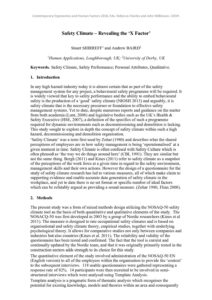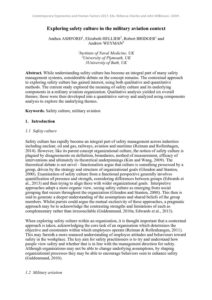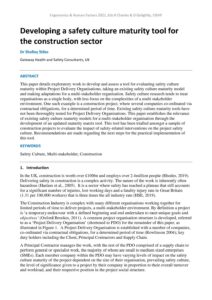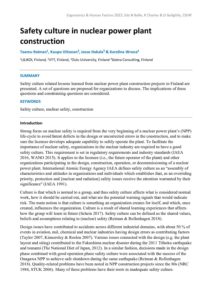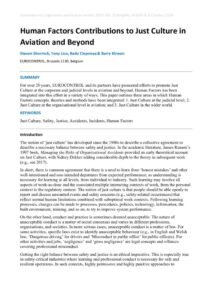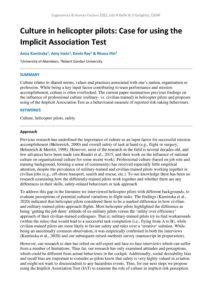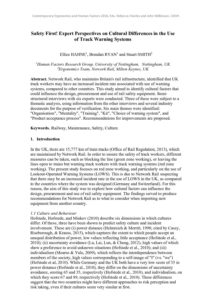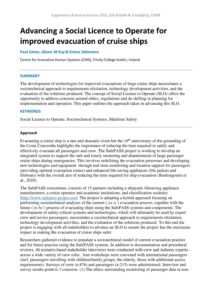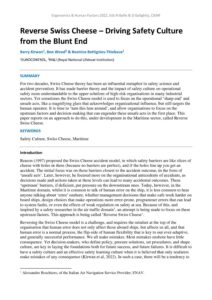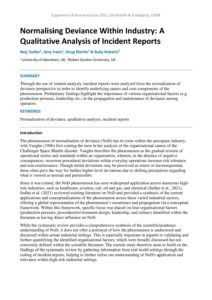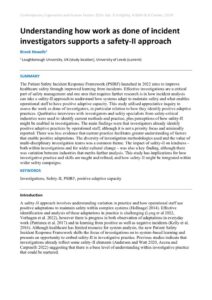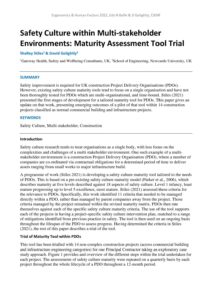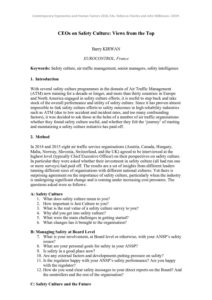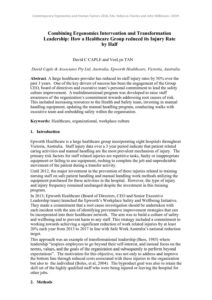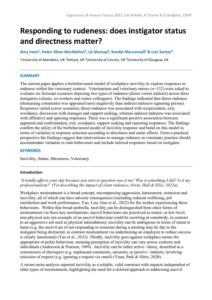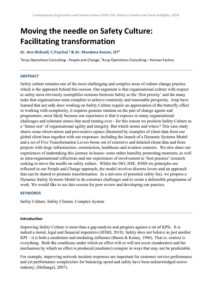Safety culture
Safety Climate – Revealing the ‘X Factor’
| Document | Author Stuart SHIRREFF and Andrew BAIRD |
| Abstract |
Exploring safety culture in the military aviation context
| Document | Author Anthea ASHFORD, Elizabeth HELLIER, Robert BRIDGER and Andrew WEYMAN |
| Abstract While understanding safety culture has become an integral part of many safety management systems, considerable debate on the concept remains. The contextual approach to exploring safety culture has gained interest, using both qualitative and quantitative methods. The current study explored the meaning of safety culture and its underlying components in a military aviation organization. Qualitative analysis yielded six overall themes; these were then developed into a quantitative survey and analyzed using components analysis to explore the underlying themes. |
Developing a safety culture maturity tool for the construction sector
| Document | Author Shelley Stiles |
| Abstract This paper details exploratory work to develop and assess a tool for evaluating safety culture maturity within Project Delivery Organisations, taking an existing safety culture maturity model and making adaptations for a multi-stakeholder organisation. Safety culture research tends to treat organisations as a single body, with less focus on the complexities of a multi stakeholder environment. One such example is a construction project, where several companies co-ordinated via contractual obligations, for a determined period of time. Existing safety culture maturity tools have not been thoroughly tested for Project Delivery Organisations. This paper establishes the relevance of existing safety culture maturity models for a multi-stakeholder organisation through the development of an updated maturity matrix tool. This tool has been trialled amongst a sample of construction projects to evaluate the impact of safety-related interventions on the project safety culture. Recommendations are made regarding the next steps for the practical implementation of this tool. |
Safety culture in nuclear power plant construction
| Document | Author Teemu Reiman, Kaupo Viitanen, Jesse Hakala & Karolina Wrona |
| Abstract Safety culture related lessons learned from nuclear power plant construction projects in Finland are presented. A set of questions are proposed for organizations to discuss. The implications of these questions and constraining questions are considered. |
Human Factors Contributions to Just Culture in Aviation and Beyond
| Document | Author Steven Shorrock, Tony Licu, Radu Cioponea & Barry Kirwan |
| Abstract For over 20 years, EUROCONTROL and its partners have pioneered efforts to promote Just Culture at the corporate and judicial levels in aviation and beyond. Human Factors has been integrated into this effort in a variety of ways. This paper outlines three areas in which Human Factors concepts, theories and methods have been integrated: 1. Just Culture at the judicial level; 2. Just Culture at the organisational level in aviation; and 3. Just Culture in the wider world. |
Culture in helicopter pilots: Case for using the Implicit Association Test
| Document | Author Anna Kaminska, Amy Irwin, Devin Ray & Rhona Flin |
| Abstract Culture relates to shared norms, values and practices associated with one’s nation, organisation or profession. While being a key input factor contributing to team performance and mission accomplishment, culture is often overlooked. The current paper summarises previous findings on the influence of professional culture (military- vs. civilian-trained) in helicopter pilots and proposes using of the Implicit Association Test as a behavioural measure of reported risk-taking behaviours. |
Safety First! Expert Perspectives on Cultural Differences in the Use of Track Warning Systems
| Document | Author Ellice HAHNE, Brendan RYAN and Stuart SMITH |
| Abstract Network Rail, who maintains Britain's rail infrastructure, identified that UK track workers may have an increased incident rate associated with use of warning systems, compared to other countries. This study aimed to identify cultural factors that could influence the design, procurement and use of rail safety equipment. Semi-structured interviews with six experts were conducted. Three of these were subject to a thematic analysis, using information from the other interviews and several industry documents for the purpose of verification. Six main themes were identified: "Organisation", "Mentality", "Training", "Kit", "Choice of warning system", and "Product acceptance process". Recommendations for improvements are proposed. |
Advancing a Social Licence to Operate for improved evacuation of cruise ships
| Document | Author Paul Liston, Alison M Kay & Emma Delemere |
| Abstract The development of technologies for improved evacuations of large cruise ships necessitates a sociotechnical approach to requirements elicitation, technology development activities, and the evaluation of the solutions produced. The concept of Social Licence to Operate (SLO) offers the opportunity to address concerns around ethics, regulations and de-skilling in planning for implementation and operation. This paper outlines the approach taken in advancing this SLO. |
Reverse Swiss Cheese – Driving Safety Culture from the Blunt End
| Document | Author Barry Kirwan, Ben Wood & Beatrice Bettignies-Thiebaux |
| Abstract For two decades, Swiss Cheese theory has been an influential metaphor in safety science and accident prevention. It has made barrier theory and the impact of safety culture on operational safety more understandable to the upper echelons of high-risk organisations in many industrial sectors. Yet sometimes the Swiss Cheese model is used to focus on the operational ‘sharp end’ and unsafe acts, like a magnifying glass that acknowledges organizational influence, but still targets the human operator. It is time to ‘turn this lens around’, and allow organisations to focus on the upstream factors and decision-making that can engender these unsafe acts in the first place. This paper reports on an approach to do this, under development in the Maritime sector, called Reverse Swiss Cheese. |
Normalising Deviance Within Industry: A Qualitative Analysis of Incident Reports
| Document | Author Nejc Sedlar, Amy Irwin, Doug Martin & Ruby Roberts |
| Abstract Through the use of content analysis, incident reports were analysed from the normalisation of deviance perspective in order to identify underlying causes and core components of the phenomenon. Preliminary findings highlight the importance of various organisational factors (e.g. production pressure, leadership etc.) in the propagation and maintenance of deviance among operators. |
Physical and social isolation in various places of work
| Document | Author Anne Aidla, Helen Poltimäe, Kärt Rõigas & Eneli Kindsiko |
| Abstract Our results indicate that dealing with the consequences of physical and social isolation may be an issue not only for teleworkers but also for non-teleworkers. What is more, both types of isolation may manifest differently depending on the office type (single cell, shared cell, activity-based or open-plan) and the amount of time one works in the same room with co-workers. |
Understanding how work as done of incident investigators supports a safety-II approach
| Document | Author Brook Howells |
| Abstract The Patient Safety Incident Response Framework (PSIRF) launched in 2022 aims to improve healthcare safety through improved learning from incidents. Effective investigations are a critical part of safety management and one area that requires further research is in how incident analysis can take a safety-II approach to understand how systems adapt to maintain safety and what enables operational staff to have positive adaptive capacity. This study utilised appreciative inquiry to assess the work as done of investigators, in particular relation to how they identify positive adaptive practices. Qualitative interviews with investigators and safety specialists from safety-critical industries were used to identify current methods and practice, plus perceptions of how safety-II might be enabled in investigations. The main findings were that investigators already identify positive adaptive practices by operational staff, although it is not a priority focus and minimally reported. There was less evidence that current practice facilitates greater understanding of factors that enable positive adaptations. The diversity of investigation methodologies used and the value of multi-disciplinary investigation teams was a common theme. The impact of safety-II on kindness – both within investigations and for wider cultural change – was also a key finding, although there was variation between industries that merits further analysis. This study has implications for how investigative practice and skills are taught and refined, and how safety-II might be integrated within wider safety campaigns. |
Safety Culture within Multi-stakeholder Environments: Maturity Assessment Tool Trial
| Document | Author Shelley Stiles & David Golightly |
| Abstract Safety improvement is required for UK construction Project Delivery Organisations (PDOs). However, existing safety culture maturity tools tend to focus on a single organisation and have not been thoroughly tested for PDOs which are multi-organisational, and time-bound. Stiles (2021) presented the first stages of development for a tailored maturity tool for PDOs. This paper gives an update on that work, presenting emerging outcomes of a pilot of that tool within 14 construction projects classified as normal commercial building and infrastructure projects. |
CEOs on Safety Culture: Views from the Top
| Document | Author Barry KIRWAN |
| Abstract |
Combining Ergonomics Intervention and Transformation Leadership: How a Healthcare Group reduced its Injury Rate by Half
| Document | Author David C CAPLE and VeeLyn TAN |
| Abstract A large healthcare provider has reduced its staff injury rates by 50% over the past 3 years. One of the key drivers of success has been the engagement of the Group CEO, board of directives and executive team’s personal commitment to lead the safety culture improvement. A multidimensional program was developed to raise staff awareness of the organization’s commitment towards addressing root causes of risk. This included increasing resources to the Health and Safety team, investing in manual handling equipment, updating the manual handling program, conducting walks with executive team and embedding safety within the organisation. |
Responding to rudeness: does instigator status and directness matter?
| Document | Author Amy Irwin, Helen Silver-MacMahon, Liz Mossop, Kendyl Macconnell & Luiz Santos |
| Abstract The current paper applies a biobehavioural model of workplace incivility to explore responses to rudeness within the veterinary context. Veterinarians and veterinary nurses (n=132) were asked to evaluate six fictional scenarios depicting two types of rudeness (direct versus indirect) across three instigators (clients, co-workers and senior colleagues). The findings indicated that direct rudeness (demeaning comments) was appraised more negatively than indirect rudeness (ignoring person). Responses varied across scenarios; direct rudeness was associated with reciprocation, exit, avoidance, discussion with manager and support seeking, whereas indirect rudeness was associated with affiliative and ignoring responses. There was a significant positive association between appraisal and confrontation, exit, avoidance, support seeking and reporting responses. The findings confirm the utility of the biobehavioural model of incivility response and build on this model in terms of variation in response selection according to directness and status effects. From a practical perspective the findings suggest that interventions to manage rudeness in veterinary practice should accommodate variation in rude behaviours and include tailored responses based on instigator. |
Moving the needle on Safety Culture: Facilitating transformation
| Document | Author Dr. Ann Bicknell, C.Psychol. & Dr. Mandana Kazem, IET |
| Abstract Safety culture remains one of the most challenging and complex areas of culture change practice which is the approach behind this session. Our argument is that organisational culture with respect to safety most obviously exemplifies tensions between Safety as the ‘first priority’ and the many tasks that organisations must complete to achieve continuity and reasonable prosperity. Arup have learned that not only does working on Safety Culture require an appreciation of the butterfly effect in working with complexity, it requires genuine stamina on the part of change agents and programmes, most likely because our experience is that it exposes so many organisational challenges and reluctant stones that need turning over - for this reason we position Safety Culture as a ‘litmus test’ of organisational agility and integrity. But which stones and where? This case study shares some observations and provocative opines illustrated by examples of client data from our global client base together with our responses: including the launch of a Dynamic Systems Model and a set of Five Transformation Levers borne out of extensive and detailed client data and from projects with large infrastructure, construction, healthcare and aviation contexts. We also share our experiences of undertaking this journey in-house: some rather humility promoting moments, as well as intra-organisational reflections and our experiences of involvement in ‘best practice’ research seeking to move the needle on safety culture. Whilst the ISO, HSE, IOSH etc principles are reflected in our People and Change approach, the model involves discrete levers and an approach that can be shared to promote transformation. In a universe of potential safety foci, we propose a Dynamic Safety Systems Model to de-construct challenges and to create a defensible programme of work. We would like to use this session for peer review and developing our practice. |

